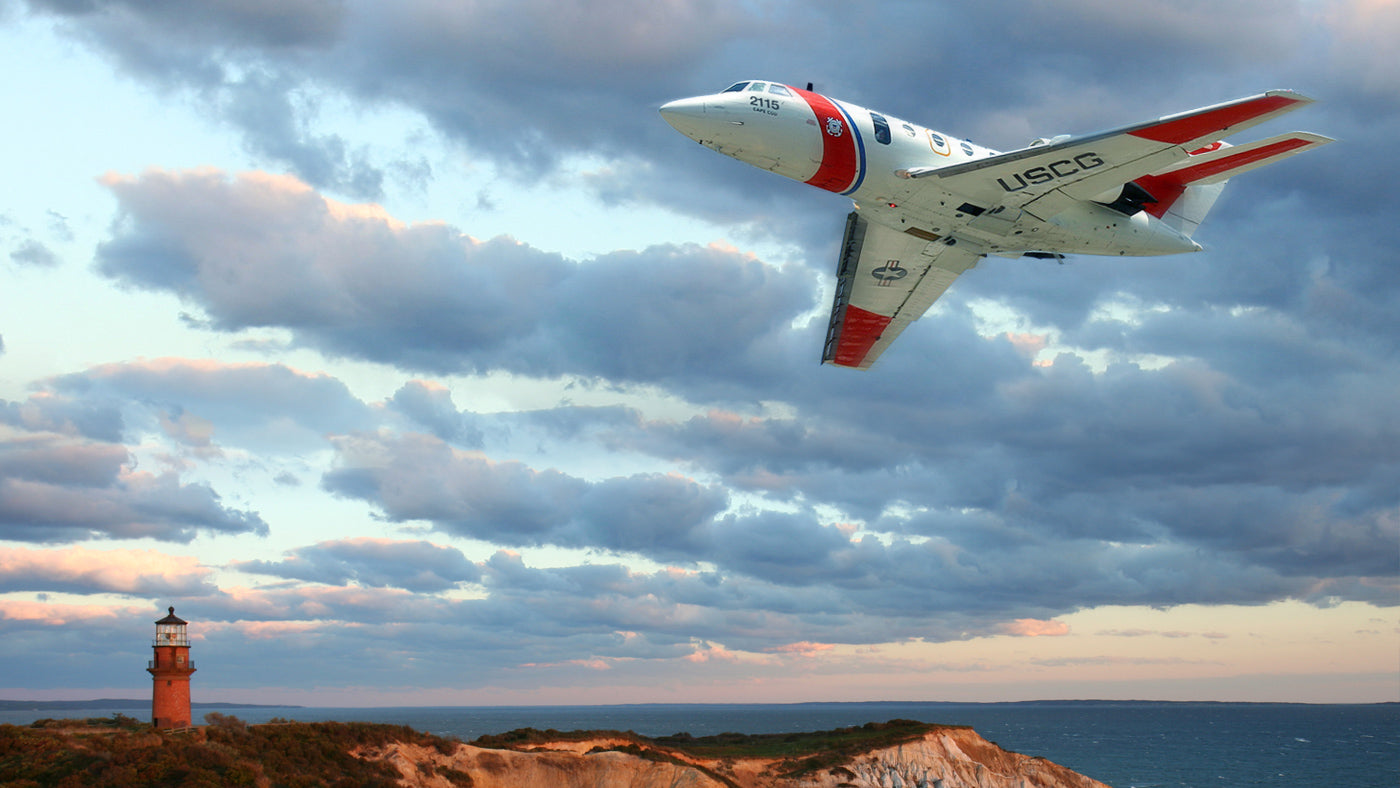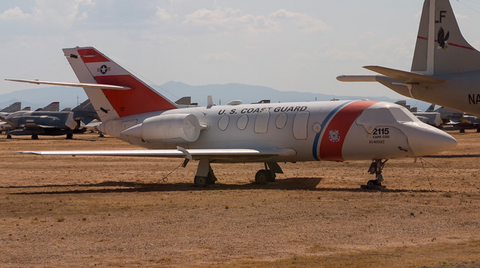
- by Dianna Lopez
Dassault HU-25 Guardian: The US Coast Guard Falcon
- by Dianna Lopez
A question? Visit our contact page
This site uses cookies for better user experience and analytics.

The Dassault HU-25A Guardian was a crucial asset to the USCG's fleet, providing critical support for maritime safety and security missions. Its versatility, speed, and advanced equipment make it an essential tool in protecting the nation's borders and saving lives at sea. Read more about the Guardian and don’t miss adding a Dassault HU-25 to your own PlaneTags collection.
The Dassault HU-25A Guardian is a versatile and reliable aircraft which was used by the United States Coast Guard (USCG) for various missions, including search and rescue, surveillance, and law enforcement. It is a modified version of the French-made Dassault Falcon 20 business jet and was in service with the USCG from 1982 to 2014.

Dassault HU-25D Guardian ‘2113 flickr photo by HawkeyeUK shared under a Creative Commons (BY-SA) license
The Guardian's primary role was to patrol and protect the United States' maritime borders and enforce laws and regulations on the water. It was equipped with advanced radar, sensors, and cameras that allowed it to detect and track vessels in all weather conditions. It also had a range of communication equipment, including radios and satellite communication, to facilitate coordination with other agencies.
The Guardian was capable of operating from both land and water, making it ideal for search and rescue missions. It could fly at high speeds and altitudes, and its short takeoff and landing capability allowed it to access remote or confined areas quickly. The aircraft was also equipped with specialized rescue equipment, including a hoist, life rafts, and survival gear, to aid in rescue operations.
The Dassault HU-25 Guardian was developed by Dassault Aviation, a French aircraft manufacturer, in the 1970s as a business jet. In 1981, the company was awarded a contract by the United States Coast Guard (USCG) to modify the Falcon 20 for use in maritime surveillance and search and rescue operations. The resulting aircraft was designated the HU-25A Guardian and first entered service with the USCG in 1982.

Guardian flickr photo by qnr shared under a Creative Commons (BY-SA) license
To meet the USCG's requirements, Dassault Aviation made several modifications to the Falcon 20 design. The most significant changes included adding a large radome on the nose of the aircraft to house advanced radar and sensors, as well as strengthening the airframe for operations in harsh maritime environments. The Guardian was also fitted with specialized equipment, such as a rescue hoist and a maritime surveillance system, to enhance its search and rescue capabilities.
The HU-25A Guardian went through several upgrades throughout its service life, including avionics upgrades, engine upgrades, and modifications to the aircraft's mission equipment. In 1989, Dassault Aviation delivered an upgraded version of the aircraft, the HU-25C Guardian, which featured improved radar and surveillance capabilities. The Guardian remained in service with the USCG until it was retired in 2014, after more than three decades of reliable service. Today, the HU-25A Guardian continues to be regarded as a highly capable aircraft, and its development represents a successful collaboration between French and American aviation industries.


Photo by DdePruis, used with permission. Photo taken in 2009
Our Guardian, S/N 2115, was constructed as an HU-25A and delivered to the United States Coast Guard in 1983. 2115 served with CGAS (Coast Guard Air Station) San Diego and CGAS Cape Cod. Its missions included search and rescue operations, maritime surveillance, and law enforcement. With a range of up to 2,000 nautical miles and the ability to stay airborne for up to six hours, it was ideal for conducting long-range patrols over vast ocean waters. Equipped with a variety of sensors - including radar, infrared cameras, and other advanced avionics - the Guardian had the ability to locate and track vessels in all types of weather conditions. The Guardian was also used to enforce U.S. laws and treaties, such as interdiction of drug shipments and illegal immigration. After retiring to the AMARC in 2001, it made its final landing at at Pima Air and Space Museum in 2014.
The Pima Air and Space Museum, located in Tucson, Arizona, is one of the largest non-government-funded aviation museums in the world. The museum is home to around 400 historic aircraft, including military and civilian planes, helicopters, and even a space shuttle rocket booster. One of the museum's primary objectives is to preserve aviation history for future generations. To achieve this, the museum has a dedicated restoration and preservation team that works tirelessly to restore and maintain aircraft in their collection. The team employs traditional preservation techniques such as sanding, painting, and repairing damaged components, and also utilizes modern technologies like 3D printing to create replacement parts. Pima has generously provided MotoArt with material from such projects so that the stories of these aircraft can be shared with the next generation.
 Photo by ZD703, used with permission. Taken 2015 at the storage/restoration area at Pima Museum, just across from Davis-Monthan Air Base.
Photo by ZD703, used with permission. Taken 2015 at the storage/restoration area at Pima Museum, just across from Davis-Monthan Air Base.
In addition to their preservation efforts, the museum also offers educational programs and tours to engage visitors and promote a deeper understanding and appreciation of aviation and military history. Through their efforts, the Pima Air and Space Museum is helping to ensure that the stories and innovations of the aviation industry are not forgotten.
Pima Air and Space Museum has two Guardians - 2115 and 2132. Number 2132 is on display. See this Pima video, discussing the Dassault HU-25 Guardian.
MotoArt owner Dave Hall was honored to work again with Pima Air and Space Museum to create HU-25 Guardian PlaneTags. “The Dassault Guardian is the newest plane in a series we are working on with material provided by Pima,” says Hall. “It’s pretty cool to have this opportunity to work with such a prestigious organization and have them as advocates for what we do with PlaneTags.” The team headed out to the Arizona desert to retrieve the skin from number 2115. Here are some photos from the team.







The newest PlaneTags are made from the authentic skin of a Dassault Aviation HU-25. They are numbered in a series of 2,750 and will initially be available in the following variants:
As with every PlaneTags release, there are some variants which will sell out almost immediately because there is just not that much of the material. Make sure you are signed up for our mailing list and follow PlaneTags on social media so you don't miss a release.



From Warbird to Water Bomber: The Epic Life of the Hawaii Mars
In the world of aviation, few aircraft have lived a life as large, or as long, as the Hawaii Mars. Towering over most of its contemporaries with a wingspan of 200 feet, this mighty flying boat was born in the final days of World War II, then quietly transformed into one of the most iconic aerial firefighting aircraft the world has ever seen. From military transport to firefighting titan, the Hawaii Mars represents one of aviation’s most extraordinary second acts.
In 2025, MotoArt obtained an original wing of this aircraft and created special PlaneTags, made exclusively for the Martin family members and Mars workers. On December 11, 2025, Hawaii Mars PlaneTags will be available to the general public for the first time.
F-14 Tomcat Coasters: A Legendary Fighter Reimagined for Your Home
Few aircraft define an era quite like the Grumman F-14 Tomcat. Sleek, powerful, and unmistakably iconic, the Tomcat was the Navy’s premier fleet defense fighter for more than three decades. From Cold War missions to pop culture stardom, the F-14 remains one of the most recognizable and beloved aircraft ever built. Today, MotoArt is proud to introduce the F-14 Tomcat Coaster Set, created from authentic F-14 aircraft material.
PR-AJB: The Story of an Azul Airbus A320 With a Global Journey
Every airplane has a story, and some travel farther than others before their flying days are over. PR-AJB was one of those well-traveled aircraft. This Airbus A320 started its life flying British families on long-awaited holidays, then later crossed the Atlantic to join the growing fleet of Azul Linhas Aéreas Brasileiras. Over nearly nineteen years it picked up new registrations, new paint, new routes and a new home, carrying thousands of passengers along the way.
Its journey reflects how widely the A320 family has spread around the world and how easily these aircraft adapt to whatever their next chapter requires. PR-AJB also arrived at Azul during an important period of expansion as the airline worked to connect more cities across Brazil. In this blog we will explore where the aircraft came from, what it did during its short time with Azul, and how it eventually came to rest in Florida. We will also share how MotoArt recovered material from the retired airframe and created PlaneTags so its story can continue in a new way.


Share:
Boeing 737: The Piedmont Pacemaker
Aloha Airlines 737-200: Pioneering Low-Cost Air Travel in Hawaii